It’s happened to all of us at one point in time. You finish up mowing and edging, and it’s time to grab the blower and finish the job.
Just when you start up your leaf blower the skies open up and it starts raining. Sometimes it’s raining too hard even to consider leaving the garage, but other times, if it’s just a drizzle, it may have you wondering if you can use a leaf blower in the rain. We are here to offer a little insight and let you know the positives and negatives of using a leaf blower in the rain.
Gas vs. Electric
The two most common types of leaf blowers are gas and electric. There are some risks involved with using both types of blowers in the rain. You should be aware of these risks before making any decisions.
Electric Leaf Blowers
If you try to use an electric leaf blower in the rain, there is a chance of electrocution. These machines were not designed to be used in wet conditions. In addition to the risk of electrocution (which should be enough to discourage you), the blower getting wet could cause it to short circuit, effectively ruining your unit.
Gas Leaf Blowers
Although it is a bit safer for you to use the gas blower in a rainstorm, it is not safer for the blower itself. Being that this is a gas blower you are using, there can be issues with water getting into the gas. Your air filter will likely get soaked and cause water to travel through your leaf blower.
If you end up with water mixed with the gas in your blower you will have some mechanical issues to deal with. Water covering the outside of the blower will also cause rust and deterioration long-term, which can make a loud leaf blower even louder.
What should you do if a leaf blower gets wet?
Now that we have established that it is generally not a good idea to use your leaf blower in the rain, what can you do if your leaf blower got wet? Sometimes you may have just been caught in a quick storm, or somehow your leaf blower got left overnight. There are a few steps you should take to preserve the longevity of your leaf blower.
- Disconnect all sources of power
- Use a towel to try off the outside of the leaf blower
- Tilt the blower in several different directions to try and dump out any standing water
- Use a blow dryer to dry off any internal parts where you can still see water
- If you don’t want to use a blow dryer, then give your blower a few days to dry out on its own. This is an acceptable and sometimes more natural method, but it will take quite a bit longer.
Can you leaf blow wet leaves?
We have pretty much established that using the leaf blower in the rain is not worth it.
The following information is just to help seal the deal. Blowing leaves or other small yard debris in the rain is extremely ineffective. Wet leaves are incredibly sticky and heavy when wet. If you don’t have the right power or the correct narrow stream of air directed at these leaves, you will struggle to even move the leaves off the walkway or driveway.
As frustrating as it can be to leave a job incomplete, it is worth waiting until the storm passes over and getting things cleaned up at that point. However, don’t wait too long, or you could end up dealing with a slippery deck.
Ideal conditions
The ideal conditions to run a leaf blower is in a dry, moderately humid environment. If you run a leaf blower in low humidity, you actually run the risk of a static shock. These shocks aren’t typically dangerous, but can be uncomfortable.

